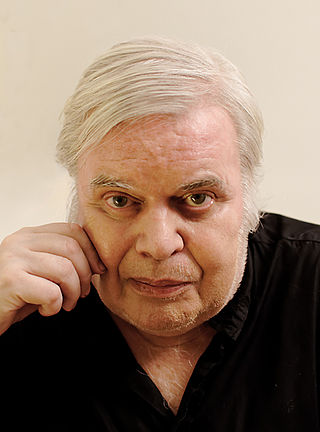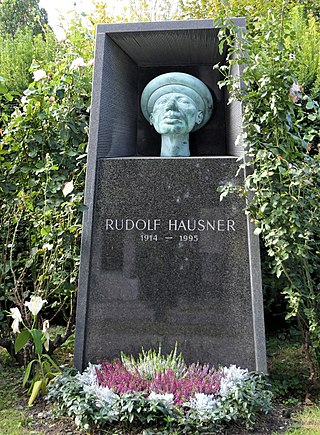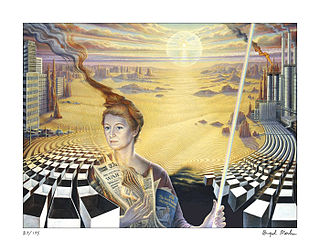
Hans Ruedi Giger was a Swiss artist best known for his airbrushed images that blended human physiques with machines, an art style known as "biomechanical". Giger later abandoned airbrush for pastels, markers and ink. He was part of the special effects team that won an Academy Award for the visual design of Ridley Scott's 1979 sci-fi horror film Alien, and was responsible for creating the titular Alien itself. His work is on permanent display at the H.R. Giger Museum in Gruyères, Switzerland. His style has been adapted to many forms of media, including album covers, furniture, tattoos and video games.

Visionary art is art that purports to transcend the physical world and portray a wider vision of awareness including spiritual or mystical themes, or is based in such experiences.
The Vienna School of Fantastic Realism is a group of artists founded in Vienna in 1946. The group's name was coined in the 1950s by Johann Muskik, and the first exhibition was in 1959 at the Vienna Belvedere. This Austrian movement has similarities to Surrealism in its use of religious and esoteric symbolism and also the choice of a naturalistic style, countering the prevalence of abstract art movements at the time.

Ernst Fuchs was an Austrian painter, draftsman, printmaker, sculptor, architect, stage designer, composer, poet, and one of the founders of the Vienna School of Fantastic Realism. In 1972, he acquired the derelict Otto Wagner Villa in Hütteldorf, which he restored and transformed. The villa was inaugurated as the Ernst Fuchs Museum in 1988.
Events from the year 1946 in art.

Rudolf Hausner was an Austrian painter, draughtsman, printmaker and sculptor. Hausner has been described as a "psychic realist" and "the first psychoanalytical painter".

Anton Lehmden was an Austrian painter, draughtsman, and printmaker.

Albert Paris Gütersloh was an Austrian painter and writer.

Abdul Mati Klarwein was a German painter best known for his works used on the covers of music albums.
De Es Schwertberger, commonly known simply as De Es, is an Austrian artist, painter and modeller. His work has been shown in exhibitions in New York City, where he lived for a short time, and Switzerland.

Brigid Marlin is an American artist based in Hertfordshire, UK. She studied in Dublin, Montreal, New York, Paris and Vienna where, under the guidance of the Austrian artist Ernst Fuchs, she learned the oil and egg tempera technique (Mischtechnik) of the Flemish and Italian Renaissance painters Jan van Eyck and Giovanni Bellini. In 1961 she founded the ins-cape group, which subsequently became the Society for Art of Imagination.
Amanda Sage is an American painter who has studied and worked in Vienna, Austria and Los Angeles, California. She trained and worked with Ernst and Michael Fuchs, a classical artist who taught her Mischtechnik. Through Fuchs she came to know other Visionary artists with whom she has worked, exhibited and co-founded the Academy of Visionary Art in Vienna and the Colorado Alliance for Visionary Art. Sage is a lecturer, teacher, and live artist with works in international galleries and museums.
Mischtechnik or mixed technique is a term spanning various methods of layering paint, including the usage of different substances. The term gained popularity after Max Doerner's 1921 book The Materials of the Artist and Their Use in Painting: With Notes on the Techniques of the Old Masters However, Doerner made some conclusions about the usage by painters and Mischtechnik which today are no longer considered completely accurate.

Peter Gric, or Petr Gric, is an Austrian painter, drawer, and illustrator originally from the Czech Republic. Motifs of futuristic landscapes and architecture, biomechanical surrealism, and fantastic realism can be found in his work. Gric is a member of the art groups Libellule and Labyrinthe.
Robert Remsen Vickrey was a Massachusetts-based artist and author who specialized in the ancient medium of egg tempera. His paintings are surreal dreamlike visions of sunset shadows of bicycles, nuns in front of mural-painted brick walls, and children playing.

Laurence Caruana is a Maltese artist, writer, and lecturer noted for his contribution to the contemporary visionary art movement, particularly through his Manifesto of Visionary Art.

Boris Alexandrovitch Chetkov was a Russian painter and glass artist known for his vivid works which range across genres but can be loosely aligned with Expressionism, Abstract Expressionism and Figurative Expressionism. His theories on art and use of colour also align him broadly with Modernism and Kandinsky though in his painting he worked largely in isolation from his peers and remained disconnected from the international art community until the end of Communism. He was a member of the Saint Petersburg Union of Artists.

Michael Maschka is a German painter, sculptor, graphic artist and designer. He is an artist of Fantastic Realism.

Helmut Leherb was an Austrian artist and representative of the Vienna School of Fantastic Realism, which is close to Surrealism. He was born Helmut Leherbauer in Vienna and is also known as Maître Leherb.














